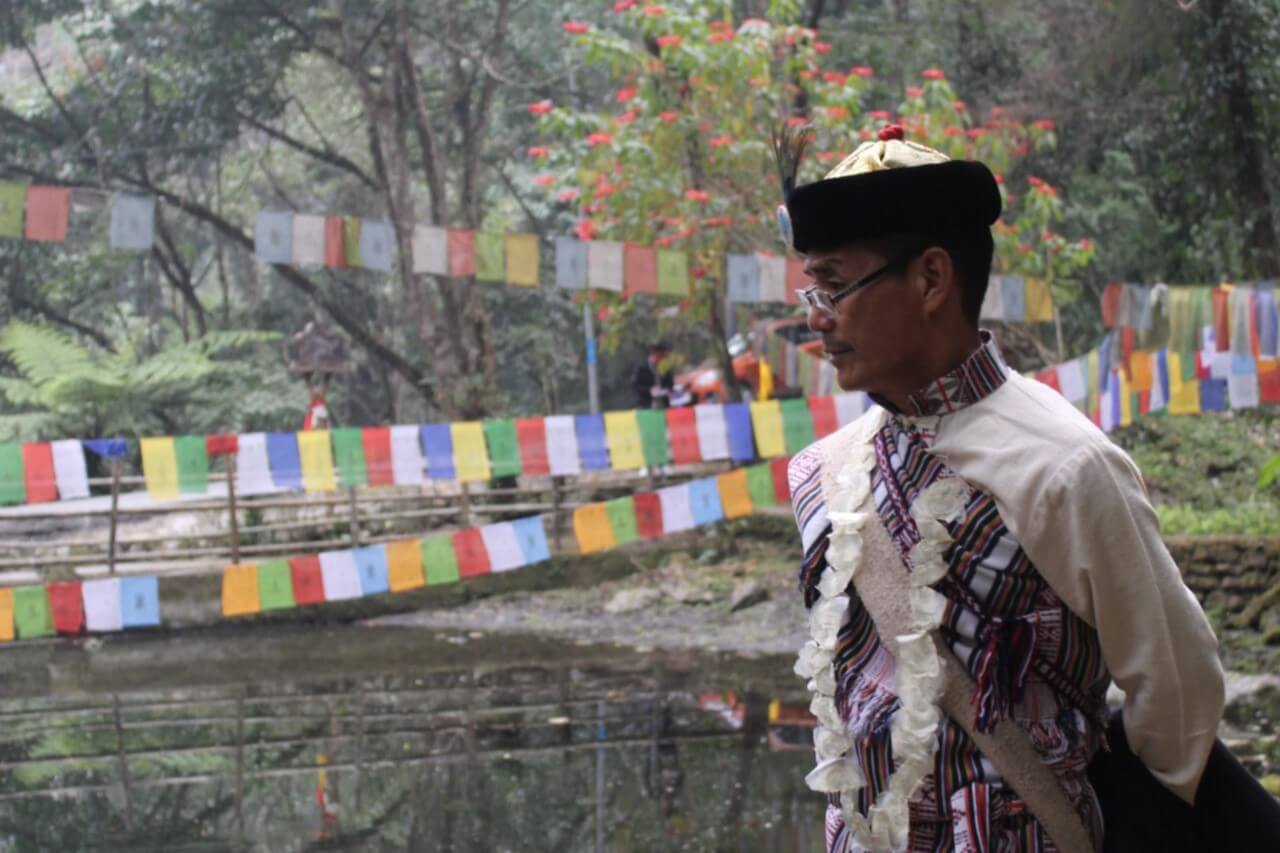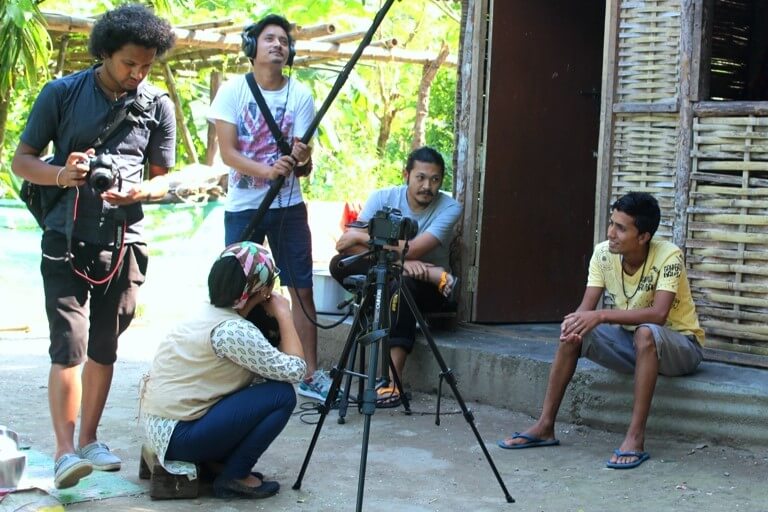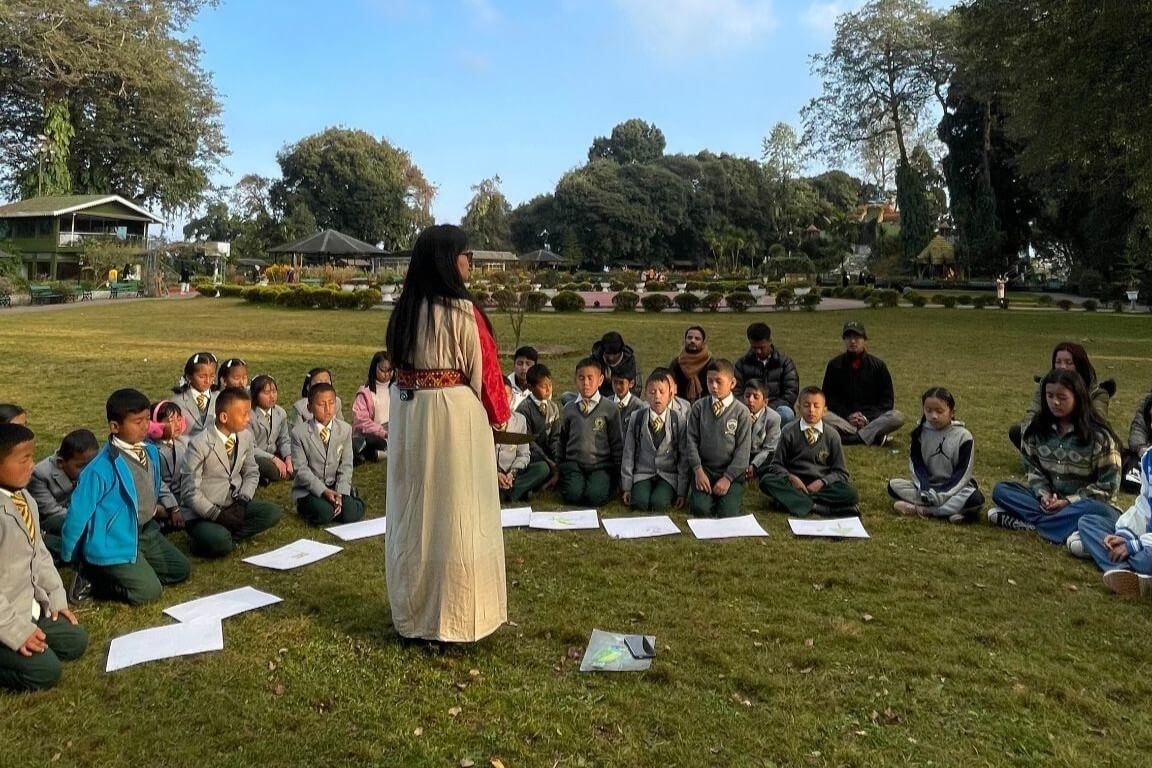A Rich Historic Ecosystem and the Lepcha Community
For millions of years, rivers have spoken their language through floods, storms, thunder, hail, and mist.
My interaction with this language of rivers began in 2007 with my own indigenous Lepcha community while I was in Delhi. To protest the hydropower development in Dzongu, Lepchas from this district in North Sikkim had arrived in Jantar Mantar, New Delhi with Affected Citizens of Teesta (ACT) banners saying “Save Holy Land of Lepchas.”
Lepchas from West Bengal supported the movement to save the last remaining Holy Land of the Lepchas. The activism further down the Teesta River fizzled out quite quickly due to socio-political reasons; the non-Lepcha population felt that it was just a ‘Lepcha thing’ and few supported the movement through the lens of environmental justice.

Dzongu still fights against the Teesta Stage IV Dam and the Panam Hydro Project just 10 kilometres away from the Khangchendzonga National Park, an Eco Sensitive Zone. There are approximately 47 hydropower development projects in different stages and 14 pharmaceutical companies on the 414 km-long River Teesta Basin, that flows through the fragile Himalayan belt – an important water tower which is the source of many rivers of South Asia.
While the Lepcha protest against dams remains a relatively modest voice in transnational dialogues, academic exploration often misunderstands or entangles the existential reality of the Lepcha worldview in the complexities of identity politics. I aim to share some of the insights gathered after I left the corporate world of Delhi to better understand my roots and reflect on the wider significance of the Lepcha protests.

About the Lepcha community
Anthropologists write that the Lepchas are the autochthons of the Himalayan state of Sikkim and the district of Darjeeling in West Bengal. According to the Government of India census of 2011, the total population of Lepchas in India was 80,316, another 3,445 live in Nepal, and constitute up to 15% of the indigenous tribal population in Bhutan, residing primarily in Samtse. UNESCO considers the Lepcha language (Rong Aring) an endangered language with only 39,342 speakers according to the 1991 Indian census.
Today, the Dzongu ‘reserve’ remains the last region of the Lepcha people in North Sikkim where traditional knowledge is still practiced to some extent, lying under the shadow of the world’s third-highest mountain, Khangchendzonga, the first in the Himalayan range that traps the monsoon clouds blowing in from the south.
Elders narrate the Lepcha creation story of Itbu Debu Rum: The story tells of the first Lepcha couple, Fudongthing and Nazong Nyu, formed by the fresh snows of Kongchen Konglo (the name in Lepcha of Khangchendzonga). We refer to ourselves as Mutanchi Rongkup RumKup, loosely translated as ‘Mother’s Loved Ones, Children of the Snowy Peaks, Children of God.’
Our oral history elucidating the local knowledge has often been dismissed as a local fairy tale.
Many Lepcha folk narratives revolve around Kongchen Konglo and rivers that melt from the same snow. We are told not to anger Matlimounyoo, Mother of Earthquake, as Itbu Debu Rum erected Kongchen Konglo on her chest to stabilize her, lying geographically in the seismic zone. When a Lepcha dies, Pildon Mun (a shaman responsible for the death ceremony) takes the spirit through the river Teesta to Pumzulyang, the resting place of our ancestors. Each Lepcha clan (putsho) has its own ‘Chu’ – a Himalayan Peak, ‘Da’ – a lake or marshland, and ‘Lep’ – a cave, door, or crack.
These peaks, lakes, and caves are found around Kongchen Konglo. The connection between the Lepcha clans and specific geographical elements like peaks, lakes, and caves reflects a deep intertwining of cultural identity with the natural environment. These landscapes are referred to as Mayel Lyang or Ney Mayel Lyang – a sacred hidden land. Mayel Lyang was mentioned in Khangchendzonga National Park’s nomination for a World Heritage Site for its ecological biodiversity and cultural significance. But the belief of Mayel Lyang is not politically or socially recognized, nor is it acknowledged outside the community.

Sadly, our oral history elucidating the local knowledge has often been dismissed as a local fairytale or left to be practiced by extremely marginalized Lepcha shamans.
Traditions of Lepcha oral history
The oral history of Lepcha is intricately linked to the environment of the Eastern Himalaya, for example, the name of the tributaries flowing from Mountain Kongchen Konglo begins with the ‘rr’ sound.
River Teesta is Rongeet, the male river, and Rongnue, the female river. The iconic lungten sung (oral tradition) of this river mentions a catastrophic deluge in the Sikkim and Darjeeling mountains signifying interactions with nature even before written history. River Teesta folklore mentions the flora, fauna, color, and shape of the two rivers that once were.
Another lungten sung tells of the ferocious river Teesta as a messenger, and slowing down the pace of the river as it cascades at Kalijhora is intricately linked to the migratory crane and sowing season of pumpkin, maize, and cucumber seeds. Today, Teesta Low Dam – IV Hydropower Plant stands at the heart of Kalijhora, generating 160 MW of electricity.
Mun (Priestess), Bongthing (Priest) and Maondaok (the Lepcha medicine man) are important practitioners of the Lepcha worldview and carriers of their traditions. They are protectors of Mayel Lyang (the land that lies in the lap of Kongchen Konglo), the river Teesta Rangeet and of every leaf, blade of grass, creature, as well as the water from the surrounding rivers and lakes of Sikkim-Darjeeling Hills.
Each Naamtho Naamthar, the Lepcha sacred manuscripts, mentions mountain peaks, caves, lakes, and various birds and insects found in the region. They have a specific rhythmic pattern to narrate these sacred verses, for instance, the Shimvonmu Ung Tuksot Nyumjyo takes the rhythm of flowing streams or rivers.
In 2016, I traced the river Teesta while directing the film ‘Voices of Teesta,’ supported by NWO (Netherlands Organization for Scientific Research) and partners. Respondents disclosed that many caves, and sacred sites were destroyed while tunnelling for the construction of the 1200 MW Teesta dam in Chungthang, North Sikkim.

They believed the deities of the mountain, or Rum, left the area with white lights leaving the rocks. Locals of Shipgyer, a village near Chungthang in North Sikkim, reported water sources above the tunnel drying up. The 1200 MW Teesta III dam was newly built then and the residents were already speaking of a disaster in the making. Amidst all the controversies, the then Government of Sikkim commissioned the state’s largest hydro dam in 2017 stating the project as ‘the only maximum revenue earner for the state in the coming years.’
Only six years later, “in the early hours of October 4, 2023, the glacier-fed South Lhonak Lake in North Sikkim breached, causing a Glacial Lake Outburst Flood (GLOF) that destroyed the state’s largest hydropower plant.” I have struggled amongst human, non-human and policy driven languages and often witnessed the language of the river and water dismissed amongst man-made boundaries.

I represent many urban indigenous youths who struggle to unlearn what has been taught and try to return to the ways of the elders. The environment intersects with our identity and our rituals. With the deaths of many of our indigenous elders, the practice of passing down this knowledge orally is disappearing fast and in an extremely colonized education and policy structure that does not address traditional knowledge, the local ecosystem or indigenous language, the sustainability of transferring this knowledge in a polarized capitalist world is a matter of great concern for me.
The knowledge of how to live with the Lepcha worldview is dying with the elders, and the modern Lepcha population is left only with memories.
People living upstream or downstream of Dzongu also have similar stories of land and river. The local versions and different narrative of the same stories reflects the biodiversity of shared culture and traditions that these stories must have lived through.
What will happen if these stories are lost at the cost of development? Protecting sacred sites of indigenous communities can protect biodiverse landscapes, but the knowledge of how to live with the Lepcha worldview is dying with the elders, and the modern indigenous population is left only with memories. When the October 2023 flood washed away the only bridge connecting Dzongu with rest of Sikkim, a solution was found in the traditional knowledge of making bamboo bridges that, under the direction of the local elders, were built within three days, helping the stranded population.
The transfer of traditional knowledge
Many children could not answer the question about the location of the river after the screening of the ‘Voices of Teesta.’ Despite the film receiving many accolades and travelled across countries, it found very limited platform and avenues of exchange within the Sikkim and Darjeeling foothills.
I realized that our detachment from our lands is because we have never been taught about local ecology. This is where my journey as a storyteller began: In 2018, I started narrating Lepcha folklore to educate people about Darjeeling and the Sikkim mountains. Using Lepcha folklore as the heart of my storytelling workshop helped me build a sense of ‘riverhood’ and reflect on the significance of local ecology. Through curated workshops in India, Nepal and Bangladesh, my intention is to highlight the transboundary nature of rivers and the interconnectedness with the Himalaya – we may speak different languages, but the language of water has been the same.

The climate anxiety in urban and rural spaces is a global concern. Current environmental discourses are visual but not experiential, whereas the act of telling stories includes songs and dances, incorporating all the senses and creating a state of reverence for interbeing – these senses and sounds cannot be written down or translated, they must be lived. Many folk narratives connect and reconnect with Mayel Lyang as an ecosystem of co-existence and interbeing.
Framing indigenous peoples at the center of climate solutions calls for a dire need to acknowledge the Lepcha view of the environment in Sikkim and Darjeeling
Framing indigenous people at the center of climate solutions calls for a dire need to acknowledge the Lepcha view of the environment in Sikkim and Darjeeling. Many researchers from around the world have contributed to the documentation of Lepcha cultural, linguistic, and historical heritage. Still, we as the young indigenous Lepcha population of the region are rapidly losing the traditional land-based knowledge that our elders used to keep.
The question remains: what happens beyond documentation or content creation, not just as a scholar or filmmaker but as indigenous custodians of the place or space? What happens to the knowledge?
In one of the workshops I organized in Northeast India, Jasmine Lepcha from Darjeeling expressed the Teesta-Rangeet story through hand-crafted artwork. Since young people spend so much time engaged with technology, the appeal of making something with her own hands was much greater. She writes, “while I was showing Teesta and Rangeet through my artwork, it was not merely two rivers but the collective emotions that we Mutanchi Rongkup Rumkup (Children of Mother Nature and God) have towards them. With every stitch, I have woven the love and gratification that I have towards the epic Teesta-Rangeet.’’

Lived culture, primarily centered on knowledge and engagement with the land, has faced historical challenges of appropriation and misinterpretation by certain groups, often with more privilege and access to resources. This has also led to the silencing, distortion or oversimplification of rich and complex Lepcha practices. River and land are integral parts of Lepcha’s existence. They are not separate. The language of water needs to be lived and understood together, not just for the Lepchas, but to protect the people of Sikkim and Darjeeling at large.
